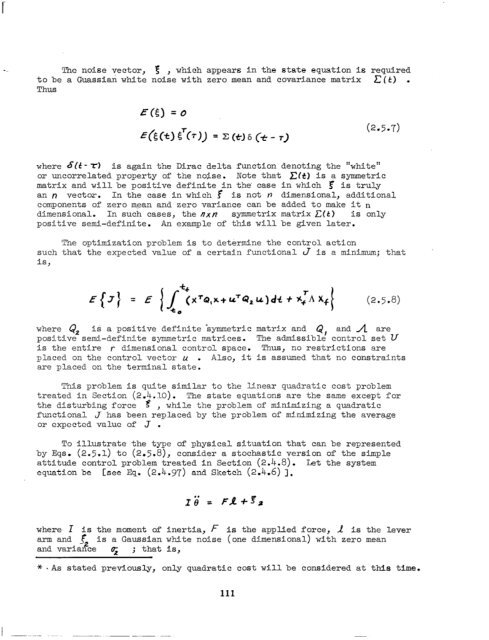guidance, flight mechanics and trajectory optimization
guidance, flight mechanics and trajectory optimization
guidance, flight mechanics and trajectory optimization
You also want an ePaper? Increase the reach of your titles
YUMPU automatically turns print PDFs into web optimized ePapers that Google loves.
The noise vector, 3 , which appears in the state equation is required<br />
to be a Guassian white noise with zero mean <strong>and</strong> covariance matrix Z:(k) l<br />
Thus<br />
(2.507)<br />
where S(ti- Y) is again the Dirac delta function denoting the 'white'<br />
or uncorrelated property of the noise. Note that x(t) is a symmetric<br />
matrix <strong>and</strong> will be positive definite in the case in which E is truly<br />
an n vector. In the case in which f is not P dimensional, additional<br />
components of zero mean <strong>and</strong> zero variance can be added to make it n<br />
dimensional. In such cases, the nxn symmetrix matrix C(t) is only<br />
positive semi-definite. An example of this will be given later.<br />
The <strong>optimization</strong> problem is to determine the control action<br />
such that the expected value of a certain functional J is a minimum; that<br />
is,<br />
(2-5.8)<br />
where Q2 is a positive definite symmetric matrix <strong>and</strong> Q <strong>and</strong> /t are<br />
positive semi-definite symmetric matrices. The admissibl: control set u<br />
is the entire r dimensional control space. Thus, no restrictions are<br />
placed on the control vector u . Also, it is assumed that no constraints<br />
are placed on the terminal state.<br />
This problem is quite similar to the linear quadratic cost problem<br />
treated in Section (2.4.10). The state equations are the same except for<br />
the disturbing force P , while<br />
functional J has been replaced<br />
or expected value of J .<br />
the problem of minimizing a quadratic<br />
by the problem of minimizing the average<br />
To illustrate the type of physical situation that can be represented<br />
by Eqs. (2.5.1) to (2.5.8), consider a stochastic version of the simple<br />
attitude control problem treated in Section (2.4.8). Let the system<br />
equation be [see Eq. (2.4.97) <strong>and</strong> Sketch (2.4,6)].<br />
where 1 is the moment of inertia, F is the applied force, 1 is the lever<br />
arm <strong>and</strong> f is a Gaussian white noise (one dimensional) with zero mean<br />
<strong>and</strong> varia&e 5 ; that is,<br />
* *As stated previously, only quadratic cost will be considered at this time.<br />
111

















